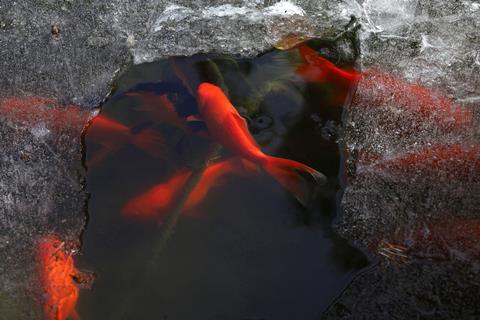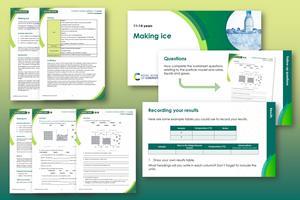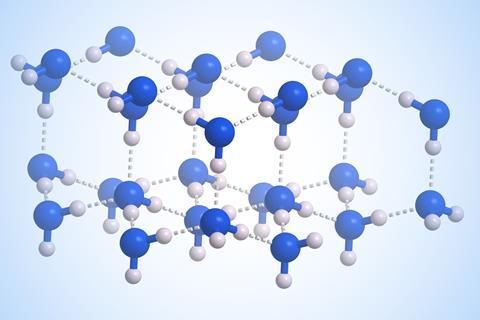Dive into the enigmatic chemistry of water and try to get to the bottom of its unusual properties
From its unique physical properties to its critical role supporting life on Earth, water is undeniably weird and wonderful. Science is just catching up with its hidden weirdness – two types of liquid structures at very low temperatures. The race is on to understand what the structures mean in the context of biology and the solar system.
What sets water apart?
Water may look like other liquids, but it certainly doesn’t behave like them. One of the most obvious properties that sets water apart is the fact that ice is less dense than liquid water and so floats on the surface. This is not the same for other liquids. For example, frozen blocks of alcohol would immediately tumble to the bottom of a container filled with liquid alcohol.

Most substances contract as they freeze, but water expands. As the temperature drops and water molecules slow down to freeze into a solid state, they form a crystalline lattice with an open, hexagonal structure, which gives a lower density. Each water molecule in the ice forms hydrogen bonds with four others. Water is most dense at 4°C, ensuring that the bottom of a lake or sea will never freeze, thus protecting aquatic organisms. This density maximum also helps water circulate through oceans.
Another interesting property is water’s heat capacity – the amount of heat required to increase the temperature of a substance by 1°C – which also determines how well a substance retains heat. Water has a much higher heat capacity than air, meaning that oceans take a long time to change temperature significantly but hold their heat well. Air that is in contact with the ocean will be cooler from energy transfer between water and air, while air that sits above land will heat up much more quickly. Therefore, water helps regulate the temperature in coastal regions.
In your class
Ask your learners what they know about water, then surprise them with some of its weird and wonderful properties using this article. Make cross-curricular links to biology, geography and physics before using the context of making ice to hone learners’ practical planning skills.
Often referred to as the universal solvent, water has a remarkable ability to dissolve a wide range of substances. This property is essential for life because water transports nutrients and minerals in living organisms. Water’s polarity, with a positively charged region near the hydrogen atoms and a negatively charged region near the oxygen atom, makes it an effective solvent for ionic compounds.
On average, water makes up 60 to 75% of human body weight. The liquid has an important structural role in cells and almost all chemical reactions in life processes take place in solution in water. Working with enzymes, water can split or hydrolyse molecules in the body, for example breaking down large carbohydrates into smaller ones such as glucose, or breaking fats into their constituent glycerol and fatty acids. Enzymes can also lead the reverse process to remove water so that simple sugars can join to form complex carbohydrates or glycerol and other molecules can form fats or lipids.
Cool science

Water’s weird properties are strongly enhanced when it is supercooled to remain liquid at temperatures well below its freezing point. This supercooling can only happen when water is ultraclean, with no impurities to spark ice formation. It is possible to cool very clean water to about -40°C without ice crystallising.
You may be able to see supercooled water crystallise at home if you place an unopened bottle of ultrapure water upright in the freezer. Place another bottle of tap water next to it. When the tap water has frozen, carefully slide the bottle of pure water out of the freezer before giving it a sudden whack to spark crystallisation.
Below -20°C, the liquid appeared to be on the verge of some kind of transformation, but the technology didn’t exist to observe it
Supercooled water commonly forms in the atmosphere, especially in clouds. Cloud droplets can exist in a supercooled state because they lack nucleation sites or ice-forming particles. This supercooled water freezes suddenly on contact with particles, such as dust or other ice crystals, or when disturbed. For example, when supercooled liquid water droplets interact with falling snowflakes, they can create snow pellets, sometimes called graupel.

Download this
Planning activity, for age range 11–14
Use this practical to develop your learners' method writing, planning and problem-solving skills while making ice.
Resources include:
Download this
Planning activity, for age range 11–14
Use this practical to develop your learners’ method writing, planning and problem-solving skills while making ice.
Download the resources from the Education in Chemistry website: rsc.li/46zOukn
Strange properties
Supercooled water has ‘many strange properties’, explains Sander Woutersen from the University of Amsterdam. For example, its specific heat and specific volume both increase with decreasing temperature, whereas the opposite occurs in all other liquids.
In 1976, Austen Angell and colleague Robin Speedy experimented to see how far they could supercool water, and how the liquid would behave at extreme temperatures. As the water temperature dipped below -20°C, its compressibility and specific heat began to rise, suggesting fluctuating density. The liquid appeared to be on the verge of some kind of transformation, but the technology didn’t exist to observe it.

In recent decades, scientists have designed computer models to try to understand what happens to water at extreme temperatures. One of the suggested theories is that supercooled water might occur in two different structural forms. After years of heated debate on the topic, scientists now understand that some of water’s weirdness comes from it being able to exist as two macroscopic phases, says Anders Nilsson from Stockholm University in Sweden.
‘The existence of such a liquid–liquid phase transition in supercooled water was a highly controversial issue. It was difficult to observe experimentally, since the transition was predicted to occur at such a low temperature that even the cleanest water would freeze before you could observe it,’ says Sander. Experts in the field have long referred to this crucial region of temperatures and pressures where supercooled water rapidly crystallises as ‘no-man’s land’.
Two-liquid hypothesis
Angell was a ‘pioneer in the research on these mysterious properties of supercooled water’, says Sander. In 2018, he ‘devised a simple and elegant method’ to study supercooled systems by adding a special kind of antifreeze that prevents freezing but does not change the structure of the water.
Sander was part of a team working with Angell to use the antifreeze hydrazinium trifluoroacetate, which fits perfectly into water’s hydrogen-bond network. As they cooled the water, they used infrared spectroscopy to measure the vibrations of O–H bonds. During cooling, at around -80°C, the researchers observed a sharp change in the liquid structure accompanied by a release of heat. The work appeared to confirm a liquid–liquid transition, suggesting high- and low-density phases.
They observed a sudden change in structure, which points to a liquid–liquid transition in no-man’s land
In 2020, Anders headed a large international team of researchers that observed the liquid–liquid transition in pure supercooled water, without needing to add antifreeze. First, they designed novel experiments using x-ray laser pulses to probe samples at around atmospheric pressure and test the two-liquid hypothesis. They created a very thin stream of tiny droplets not visible to the naked eye, which they supercooled to see the structure change continuously upon cooling.
Next, they prepared samples under pressure and at temperatures low enough to keep the water molecules static. They warmed the ultrathin ice slices with short infrared pulses which caused rapid expansion followed by decompression. They probed the system with x-ray scattering at different time delays during the decompression and observed a sudden change in structure, which points to a liquid–liquid transition in no-man’s land.
They also described detecting ice crystallisation occurring on longer time scales, confirming that the liquid–liquid transition is distinct from the liquid–ice transition. Sander and colleagues have described the experiments as ‘spectacular’.
Liquid water at extremely cold temperatures is not only relatively stable, but also exists in two structural motifs
2020 was quite the year for watery revelations. After spending more than 25 years studying the liquid, a team led by chemical physicists Bruce Kay and Greg Kimmel at the US Department of Energy’s Pacific Northwest National Laboratory also published research showing high- and low-density liquid water at supercooled temperatures.
They created thin films of ice, which they zapped with nanosecond laser pulses to create supercooled liquid water before rapidly cooling back to the start temperature. They used infrared spectroscopy to monitor changes in the water’s structure before it refroze. This technique is sensitive to the hydrogen-bonding configuration of water molecules, showing structural changes. The researchers say the study showed that liquid water at extremely cold temperatures is not only relatively stable, but also exists in two structural motifs.
More resources
- Help your younger students plan and perform successful practicals with exam-style questions where they find errors in common experimental methods.
- Practise hypothesis writing and critical thinking skills using the Candle burning investigation PowerPoint slides, student worksheet and teacher notes with answers.
- Explore evaporation with a practical worksheet for 11–14 year-old learners. Display the poster in your classroom and discover more infographics, such as the water cycle, too.
- Show learners people passionate about their jobs, such as school science technician Sandrine, who enjoys designing, testing and safely preparing exciting classroom experiments.
More resources
- Help your younger students plan and perform successful practicals by finding errors in common experimental methods: rsc.li/47NmB9l
- Practise hypothesis writing and critical thinking skills with a candle burning investigation: rsc.li/3Ggi7fG
- Display the poster and use the practical worksheet to explore evaporation with 11–14 learners: rsc.li/47OFKb1
- Show learners people passionate about chemistry and their jobs, such as school science technician Sandrine: rsc.li/3SUlReo
Although the studies seem to settle the issue of the existence of a liquid–liquid phase transition in supercooled water, ‘there are still plenty of questions left over’, says Sander. ‘For instance, what are the differences in structure and dynamics of the two liquid forms of supercooled water, and what factors determine whether a liquid can undergo a liquid–liquid transition?’
There is much work to be done. Researchers in the field say studies may help us understand how liquid water can exist on very cold planets in our solar system, such as Jupiter, Saturn, Uranus and Neptune. They can also help to understand water’s weirdness here on Earth, including in complex processes inside every cell in our bodies. Next time you take a sip of water or splash in the sea, take a moment to think about how weird and wonderful the liquid is.
Article by Emma Davies, a science writer based in Bishop’s Stortford. Resource adapted by Dorothy Warren from the book In search of more solutions















2 readers' comments